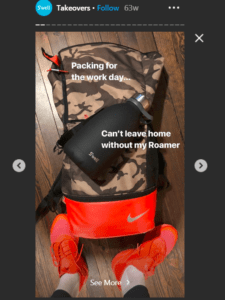Instagram has played a crucial role in the growth of reusable water bottle brand S’well, says Emily Bibb, the retailer’s global director of digital and social media.
The brand launched in 2010, the same year as Instagram. Relatively quickly, S’well began seeing its bottles, which feature bold designs, patterns and colors, featured in Instagram users’ images as a “fashion accessory,” she says. “We’d see our bottles in photos featuring meal prep, or in a gym bag.”
S’well also began posting on Instagram. And, over time, it settled on a once-a-day cadence while also sharing Instagram Stories that center on a particular theme, such as new designs. (Stories are the section of the Facebook Inc.-owned social network where users and brands can post photos and videos that disappear after 24 hours.) Those posts have helped the brand attract more than 261,000 Instagram followers.
However, the biggest boost the brand got from Instagram was about a year-and-a-half ago when it began using a number of visual analytics and Instagram tools from marketing vendor Curalate, she says.
Those tools include Curalate’s Like2Buy product that enables the retailer to drive shoppers from the visual-focused social network to SwellBottle.com. The tool allows a shopper to click a link on S’well’s Instagram profile page to bring up a gallery of Instagram photos that, when clicked, go to the item’s product page. While Instagram has been rolling out its own tools aimed at enabling users to shop on its platform, Like2Buy continues to drive traffic and sales to SwellBottle.com, Bibb says.
In addition to Like2Buy, S’well uses Curalate’s tools to find influencers and incorporate Instagram users’ images featuring its bottles on SwellBottle.com. By tying together its Instagram presence with its ecommerce site, Curalate has helped S’well better leverage the following it had long built up on the social network, she says. “Two years ago, Instagram wasn’t a sales-driving channel,” Bibb says. “Now it is. It may not be as big as paid search or affiliates or email. But it is growing quickly.”

That growth stems in part from Curalate’s influencer marketing tool that scans Instagram @ mentions and tags to find so-called micro-influencers—those consumers with modest followings, who already like the brand. The platform enables S’well to launch a campaign and reach out to influencers via email, as well as to collaborate with the influencer during the content creation phase. Within the platform, S’well distributes the influencer’s content, which often includes Instagram Stories. For example, in a recent “Takeovers”-themed Instagram Story, Brian Mazza, owner of the restaurant chain The Ainsworth, shared images from his day. In one of the Story’s images, he had a S’well bottle on top of a backpack with the caption “Packing for the work day…”
S’well found that adding user-generated content to its site drives significant results. Consumers who interact with user-generated content have a roughly fourfold increase in time on site and an eightfold increase in conversion rate compared with other shoppers.
Instagram has been a boon to S’well, Bibb says, noting that, until this year, its growth was entirely organic, save its spending on influencer marketing. But an organic-only approach doesn’t work as well as it used to. Over the past few months, the brand has noticed that its engagement and reach on the platform have dipped thanks to changes with Instagram’s algorithm.
Those changes have coincided with a significant push by Instagram to incorporate ecommerce elements. For example, earlier this year it launched Checkout, a feature that lets a shopper complete her transaction without leaving the social network.
“Instagram’s changes have impacted our organic reach,” Bibb says. That’s forced S’well to begin experimenting with Instagram’s various advertising options.
“I’m excited to see how our ads impact our organic reach,” she says, noting that the retailer has little choice but to adjust. After all, “Instagram is increasingly a pay-to-play platform.”
Favorite